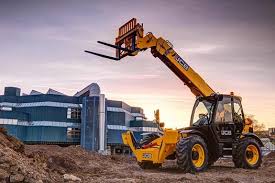What are the uses of Telehandler? How does a telehandler operate and what does it do? Telehandlers, also known as telescopic handlers, are hydraulic lifting machines frequently used in the agriculture, farming, and construction sectors.
Modern telehandlers are quick hybrid machines that combine the load-lifting capacity of a forklift with the lifting capacity of a crane.

The machines include a telescopic boom that may be equipped with different attachments to carry out a variety of activities.
Depending on the operation, operators may quickly and safely switch attachments thanks to a straightforward fast hitch design.
What a Telehandler Is and Its Benefits
- Heavy Lifting
Heavy weights can be lifted by telehandlers using the appropriate attachments, up to the lift and height limits of the device.
Forklifts can only move in one direction, but telehandlers may move diagonally. They can pick up and transport items that a standard forklift couldn’t lift thanks to the mobility.
Due to their increased agility and extendable boom, telehandlers can easily approach awkward angles and small spaces. They are therefore the ideal materials handling option for restricted spaces.
When lifting heavy weights, stabilizers may deploy from the unit to increase stability and safety.
- Versatility
A telehandler’s telescoping boom is essential to the unit’s versatility.
A variety of specially designed interchangeable attachments may mount securely to the end of the boom thanks to the device’s fast hitch mechanism.
Here are some instances of telehandler attachments and their uses:
Pallets, wood, piping, and other lengthy objects may all be lifted by forklift carriages.
Crane jibs transform a telehandler into a specialized crane that can hoist sand, liquids, and loose building materials. Unexpectedly, you may put these goods in a bucket that the crane jib lifts.
Scoop and bucket attachments can be added to telehandlers to help them move loose items like sand. Additionally, the device’s scoop attachment enables product loading into the bucket attachment prior to hoisting.
The telehandler may be equipped to lift employees to great heights so they can do their task securely.
When finishing projects, using a telehandler and its attachments may result in significant cost savings. Additionally, it can do away with the need to hire extra capital items like cranes and elevating work platforms.
- Mobility Off-Road and On-Road
Four-wheel drive telehandlers can operate on and off-road. However, the machine can lift and transport enormous loads thanks to the installation of strong, massive tires. Additionally, road registration enables units to easily transport freight to sites when unloading from delivery vehicles while operating on designated bitumen roads.
- Improved Safety
Heavy items can be hydraulically lifted and moved about a job site by telehandlers. As a result, it is less likely that someone may hurt oneself through risky or repetitive physical lifting. To provide the greatest level of safety, telehandlers must be operated on-site by highly qualified staff.
For the device to be operated correctly and safely, operators must complete the required training and possess a property license. Additionally, make sure the telehandler adheres to the required lifting height and capacity from the manufacturer. Additionally, by taking this action, the risk of accident, product or equipment damage, or even workplace deaths, is reduced.
Telehandler
In conclusion, this blog describes how to utilize telehandlers in mining, agriculture, farming, and construction.


Recent Comments